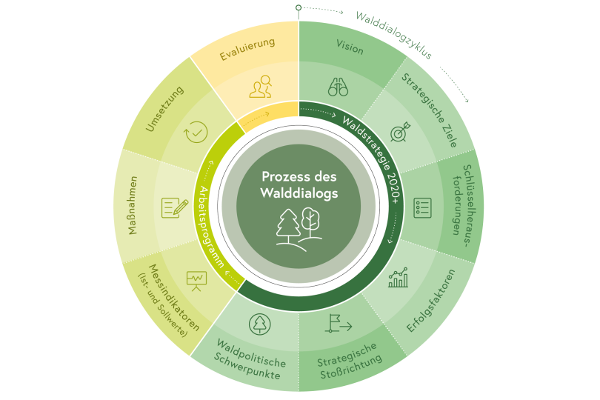How does the process of the Forest Dialogue work?

The Forest Dialogue is conceived as a long-term, ongoing process. Ideally, the Forest Dialogue and its results run through various typical phases.
The Forest Strategy 2020+ was prepared in line with the principles of a transparent, open and participatory policy and administration and in accordance with the principles and rules agreed upon in the Austrian Forest Dialogue.
After this Strategy had been approved by consensus by all participants in the Forest Dialogue and by the Round Table, a separate work programme for its implementation was developed.
The elements of the Forest Dialogue cycle
The vision
The vision outlines a situation or a state that is to be reality in the future. In the present context, it sets the direction for the orientation of forest policy and thus serves to steer forest policy action and the setting of technical priorities. In addition to the basic vision of forest policy, there are specially coordinated thematic visions for each of the seven fields of action.
The strategic objectives
Strategic objectives specify the vision. They are fundamental in nature and set the direction for targeted and active action. Ultimately, they should also be suitable for measuring success against them. For reasons of efficiency and effectiveness, the number of strategic objectives per area of action was limited to seven.
The key strategic challenges
The key strategic challenges show which current and future or internal and external framework conditions are of relevance to the realisation of the respective strategic objectives. This involves a brief and concise description of the current and future situation based on three questions:
- What is happening in the subject area of the relevant strategic objective? (Actual state)
- How is the future development of the area of the respective objective assessed? (Influencing factors and drivers with an impact on the strategic goal)
- What challenges does this pose for the subject area of the respective strategic objective?
The success factors
Success factors are those elements, aspects, instruments and framework conditions that are decisive for the successful achievement of the strategic objectives in the context of the key challenges identified. The guiding question is:
- Which factors/framework conditions/instruments contribute to achieving the respective strategic objective?
The strategic directions
The strategic priorities set the direction for the specific measures to be defined in the Strategy's implementation programme. In principle, the priorities are action-oriented, but they can also include approaches to solutions and objectives.
The work programme
The work programme comprises measurement indicators, measures and the implementation.
After the Forest Strategy 2020+ has been developed by all those involved in the Forest Dialogue and was adopted by consensus by the Round Table, a separate work programme for its implementation has to be drawn up. The work programme contains concrete measures and is the central implementation instrument of the Forest Strategy. As a "living" document, it is to be continuously developed and adapted. It is the responsibility of all institutions that are committed to the Forest Dialogue and its results to implement the measures according to the Strategy or the work programme in their area of activity.
Indicators fulfil two important functions for the Forest Dialogue. On the one hand, they are used to check how a certain status changes in relation to the desired goals. On the other hand, they enable us to assess to which extent measures contribute to the achievement of the relevant goals. By means of these two functions, indicators demonstrate any need for action.
Evaluation
At a suitable point in time, the success of the measures taken and the achievement of objectives is evaluated. On the basis of the evaluation results, the actual status of forests is reassessed and another round of the Forest Dialogue begins.